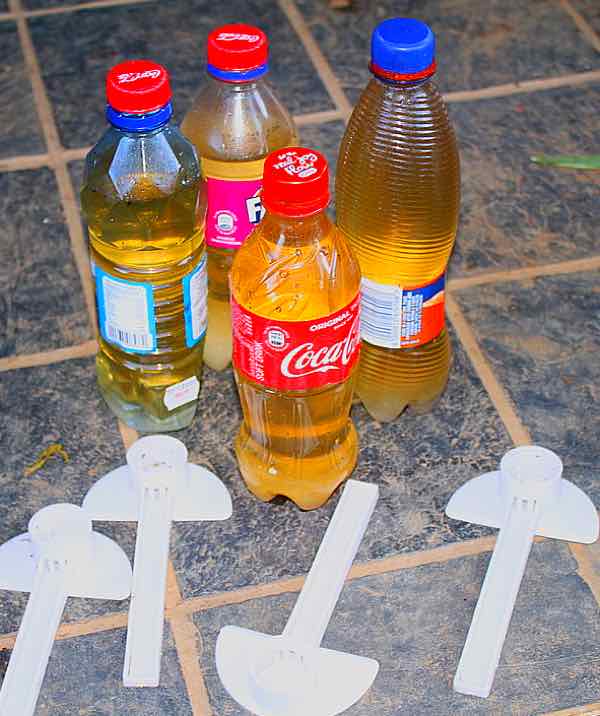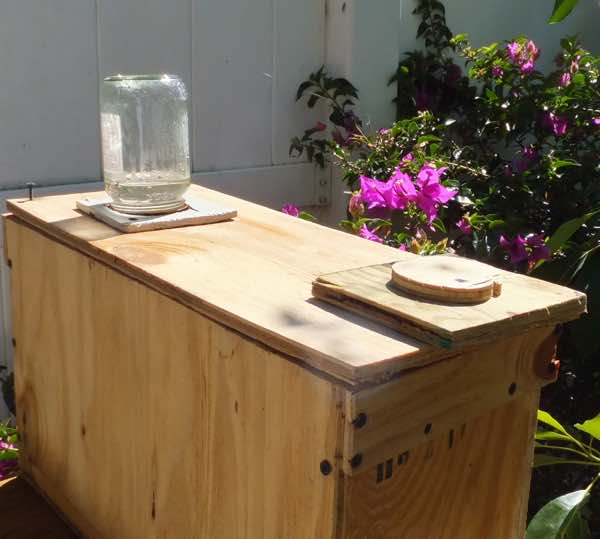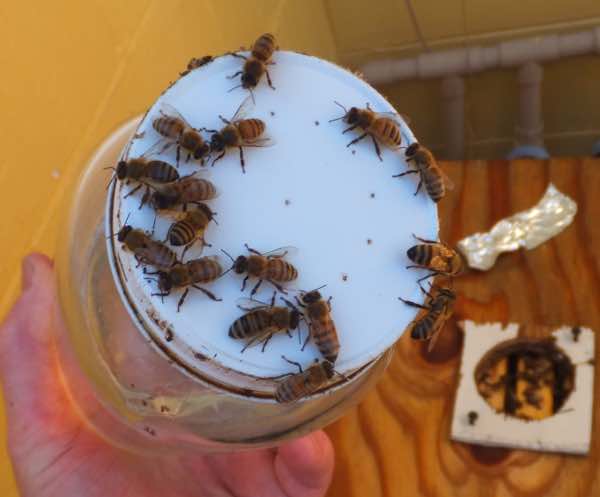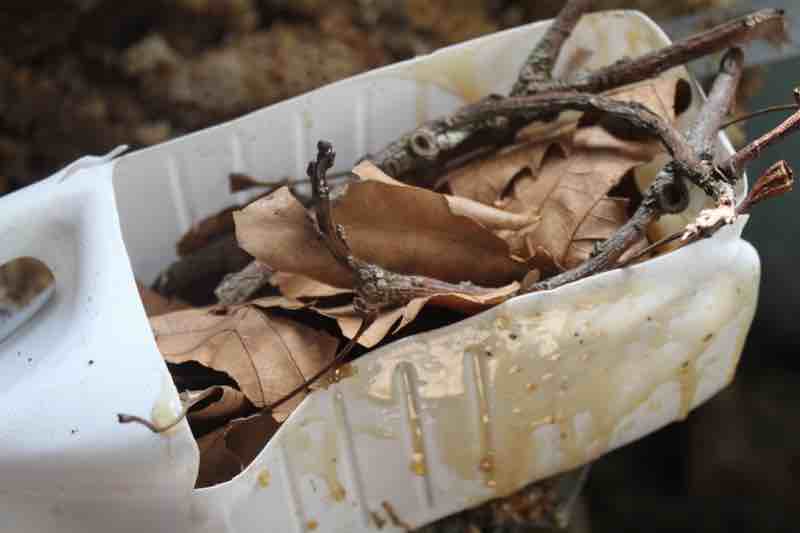- Bernard Preston homepage
- Beekeeping
- Feeding Kept Bees
Feeding kept bees
Feeding kept bees is a subject easily misunderstood. The purpose is never to adulterate the keeper's honey with sugar.
Nor is it to replace the honey we have harvested from the hives; we take only of their excess which, in a bumper season amounts to two-thirds of their hard work.
Lacking many vital phytonutrients found in the nectar from the flowers, sugar can never be a substitute.

There are two common possible reasons why you might want to feed your kept bees.
- You
anticipate a long period during which little honey or pollen is likely
to be brought into the hive by the worker bees; for example, during the prolonged cold-weather in the far north of America or in a drought.
- You want to stimulate the queen to start laying in anticipation of a honey-flow.
This page was last updated by Bernard Preston on 4th June, 2024.
Reviewed by Derek A. Lewis, beekeeper.
To encourage the workers to actually store the sugar-solution for the long winter, one makes the concentration doubly strong.
To merely stimulate the queen in an attempt to fool her into believing the honey-flow has actually started, one uses a much more dilute solution; they will not store it.
That little feeder is inserted snugly into the entrance of the hive.
With adulteration of honey so rife, the uninformed might think you are actually attempting to get the bees to suck up the sugar-solution, process it as they would nectar and then store it in the combs. Nothing could be further from the truth; except perhaps for extreme weather conditions.
Whilst the beekeeper can never absolutely guarantee that not one fed sugar-molecule might end up in a bottle of honey, that is never the purpose; we do our level best to ensure that does not happen.
Once it is clear that the flow has started and plants are actually flowering then the queen does not need further stimulation; all feeding is stopped. In any event they eschew sugar once real nectar from the blossoms is available.
Any nectar that is brought in by the workforce is then stored as genuine honey.
Feed roughly two-litres of a dilute sugar solution about a month before the expected honey flow in two tranches a few days apart. If they suck it all up, give them more.
Once the flow starts they won't touch your sugar solution; they are not stupid.
Feeding kept bees
Feeding kept bees is to sustain them during a long period of dearth or to stimulate the queen to start laying in anticipation of an expected honey-flow.
It is a standard part of normal beekeeping, and there is no intention whatsoever to adulterate the honey that you might buy with sugar-water.
Let us say for example that a honey flow lasts about two-months. Each and every nectar source will be different, some much longer and others shorter.
But let's work on eight-weeks for simplicity's sake.
Now it takes three weeks from the day the queen lays an egg until it hatches. It is then assigned hive duty for a period, and is not likely to join the workforce for another week at least.
But there is now only another fortnight of the honey-flow left for the bees to forage for nectar and store it in the combs.
By feeding your kept bees, starting to stimulate them a month earlier, you now have a hive that can collect and store honey, and a surplus for you, for six-weeks instead of only two.
In theory you can expect three-times the number of bottles, simply because you took the trouble of feeding your kept bees.
Storage for a dearth period
You would want to be feeding your kept bees a solution of two-parts of white sugar to one water to store for an anticipated dearth period; several litres.
To stimulate the queen for an anticipated flow, use equal parts of water and sugar; I work with one-litre only, in two tranches of 500ml each.
I like to add any old honey that I might have stored up for this purpose. In fact you might even purchase a few bottles of cheap stuff from the supermarket, if you would get three-times the amount back.
How to feed your kept bees
Commercial beekeepers with hundreds of colonies would simply place a large bowl of sugar syrup near the hives, covered with a thick-layer of grass to stop them from drowning.
This stirs the bees up and you may have people and animals in the neighbourhood being stung.
We are feeding our kept bees directly into the brood-chamber; then it is used for the larvae.
Putting the sugar-syrup into the supers is not advised; there is a greater likelihood of it being stored in the honeycombs instead of being fed to the young larvae.
Delayed mowing of lawns and cutting back of indigenous weeds is another good option.
New colonies
There are other reasons for feeding, some of which pertain to specialised beekeeping like queen-rearing.
If you have been lucky enough to catch a new migrating-swarm then feeding kept bees is not a bad idea until they are established.
However they do bring some stores of honey with them; swarming generally only happens when there is plenty of nectar available, so it may not be necessary.
Creating swarming bee-traps is a big subject all on its own.
Feeding a nuke hive

Cut a piece of 3/4" plywood; it sits tight and is unlikely to warp. And then another thinner plank, about 6 inches square to lift the bottle-lid off the frames in the hive beneath.

Choose a standard scrap-bottle such as a mason jar about to be recycled. Punch very small holes in the lid using a nail.
Scroll out the lid on the two-pieces of plywood; and shape it with a jigsaw.
Here is a tip; make the hole before cutting the piece to size. It is easier and safer to handle a larger plank, keeping your fingers well away from the blade.
You are feeding directly into the brood area; there is far less likelihood of robbing by neighbouring-bees than any apparatus used at the entrance.
Feeding kept bees inside the hive
Other keepers prefer feeding kept bees inside the hive. It has one great advantage; robbing from other colonies is greatly diminished.
The disadvantage is that you cannot see how quickly they have taken the feed.
- Fill a container like this cut-out milk jug, cover it thoroughly with leaves and place some sticks so they can crawl out; otherwise it may turn into a graveyard.
- Remove 2 frames from the top super and insert the container. Close the hive.
- They will usually clean up two litres of sugar solution in a couple days if they are hungry. If they haven't, give them less next time.

Open days
Most associations have various open-days where you can learn these basics like feeding kept bees.
Most are open-hearted folk willing to share their experience; see if you can find a beginners' beekeeping day near you.
More about feeding your hive in winter from a Texas homesteader[1].
When browsing use right click and "Open Link in New Tab" or you may get a bad gateway signal.
Newsletter
Our newsletter is entitled "create a cyan zone" at your home, preserving both yourself and Mother Earth for future generations; and the family too, of course. We promise not to spam you with daily emails promoting various products. You may get an occasional nudge to buy one of my books.
Here are the back issues.
- Lifestyle and ideal body weight
- What are ultra-processed foods?
- Investing in long-term health
- Diseases from plastic exposure
- Intensive lifestyle management for obesity has limited value
- A world largely devoid of Parkinson's Disease
- The impact of friendly bacteria in the tum on the prevention of cancer
- There's a hole in the bucket
- Everyone is talking about weight loss drugs
- Pull the sweet tooth
- If you suffer from heartburn plant a susu
- Refined maize meal and stunting
- Should agriculture and industry get priority for water and electricity?
- Nature is calling
- Mill your own flour
- Bake your own sourdough bread
- Microplastics from our water
- Alternative types of water storage
- Wear your clothes out
- Comfort foods
- Create a bee-friendly environment
- Go to bed slightly hungry
- Keep bees
- Blue zone folk are religious
- Reduce plastic waste
- Family is important
- What can go in compost?
- Grow broad beans for longevity
- Harvest and store sunshine
- Blue zone exercise
- Harvest and store your rainwater
- Create a cyan zone at your home
Did you find this page interesting? How about forwarding it to a friendly book or food junkie? Better still, a social media tick would help.
- Bernard Preston homepage
- Beekeeping
- Feeding Kept Bees
Address:
56 Groenekloof Rd,
Hilton, KZN
South Africa
Website:
https://www.bernard-preston.com